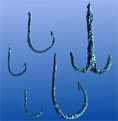
Fish-hooks, Pompeii |
|
The Vesuvian region, spreading from the seashore to the foothills and then to the mountain forests, provided ideal large game habitats far from inhabited areas. The territory was along the route of the great seasonal bird migrations, offering excellent fowl-hunting conditions. Hunting tools included bows and arrows, as well as snares and nets in suitable sizes. Prey were lured using calls, or caught by means of traps. Once the meat had been eaten, the largest bones were worked to make everyday or ornamental items while fangs and horns were kept as trophies.
Fishing techniques were highly developed and differed little from those still practiced today. A large number of bronze fish-hooks and various types of nets have been found. These, together with the descriptions passed down by classical writers and in artistic portrayals, offer us a complete overview of how the Romans gathered food resources from the sea. They even practiced undersea fishing by diving with special harpoons. |